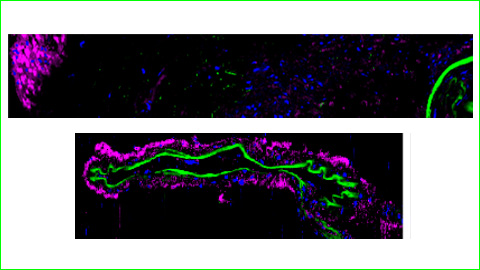
An international group of researchers, led by the UAB, identified the presence of the fat sphingosine-1-phosphate (S1P) in the meninges, and described its key role in the proper functioning of cerebral blood vessels. The study also suggests its involvement in the elimination of waste substances from the brain. The finding will help develop new drugs for the modulation of cerebral blood flow in those diseases in which it is altered.
The arachnoid is one of the three meninges, or brain membranes, and is responsible for mechanically and immunologically protecting the brain and the spinal cord. It allows communication between the cerebrospinal fluid (which bathes the brain and the spinal cord) and the cerebral blood vessels, and controls several crucial physiological responses in the brain, such as supplying nutrients and eliminating toxic waste.
Researchers from the Laboratory of Cerebral and Peripheral Vascular Diseases, at the Department of Pharmacology, Therapeutics and Toxicology, and the Institut de Neurociències of the Universitat Autònoma de Barcelona (INc-UAB) discovered that the arachnoid is a very important source of sphingosine-1-phosphate (S1P), a lipid that had hitherto been found mainly in red blood cells. Researchers show for the first time that this fat, once released from the arachnoid, produces the necessary vasoconstriction in the cerebral blood vessels for the regulation of blood flow. In addition, this process facilitates the elimination of waste substances, by generating a vascular pulsation that would help expel them through the cerebrospinal fluid. The research, done on mice and human samples, has been published in the Journal of Cerebral Blood Flow and Metabolism.
The results of the study are not only relevant to understanding the physiological role of this substance in the brain blood vessels. They also suggest that in those pathological states that present the accumulation of toxic substances, such as Alzheimer's disease, SP1 in the arachnoid could be altered. This would explain why beta-amyloid peptide clearance is reduced in Alzheimer's patients, altering proper brain function and causing cognitive dysfunction and dementia.
"In the study, we saw there is a decrease in S1P deposits with age, and we believe this could be affecting the elimination of beta-amyloid peptide, promoting the development of the disease", explains Francesc Jiménez-Altayó, UAB researcher leading the study. Jiménez-Altayó concludes that the results of the study "situate SP1 located in the arachnoid as a potential therapeutic target to modulate cerebral blood flow, to treat cerebrovascular pathologies and those that run with toxic waste in the brain".
Researchers from the Institute for Biomedical Research in Barcelona and the Eberhard Karls University in Tübingen also took part in the study.
Reference: Francesc Jiménez-Altayó et al. Arachnoid membrane as a source of sphingosine-1-phosphate that regulates mouse middle cerebral artery tone (2021). Journal of Cerebral Blood Flow and Metabolism. https://journals.sagepub.com/doi/full/10.1177/0271678X211033362






